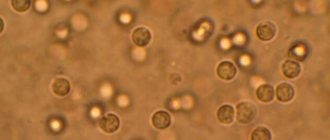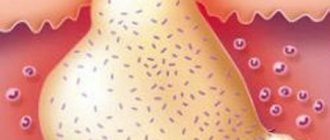Varieties of staphylococcus
Staphylococcus is a microorganism that lives on the skin and mucous membranes of humans, in the intestinal environment. Some of its varieties are harmless to the baby’s body, while others can cause negative symptoms that manifest themselves in different systems and organs.
The following types of staphylococcus are considered the most dangerous for the human body:
| Pathogen type | Its effect on the body | Habitat |
| Saprophytic | Causes acute and chronic inflammatory processes in the bladder | Mucous membranes of the urethra |
| Epidermal | Symptoms arise against the background of a weakened immune system in the postoperative period and are expressed in the development of a purulent process on the skin and in the bloodstream (sepsis), endocarditis (inflammation of the cardiac membrane) | Skin and mucous membranes |
| Golden | It manifests itself through the development of skin infectious diseases (boils, acne, phlegmon), and after entering the internal organs it becomes the cause of meningitis, inflammation of bone tissue, sepsis, mastitis, pneumonia | Skin |
In fact, there are many more varieties of the pathogen, but the golden one is considered the most unfavorable for the body of a newborn. It can enter the baby’s organs and systems through an injury to the skin (for example, through an umbilical wound).
Brief characteristics and types of infection
Staphylococcal bacteria can affect a child at any age. In newborns, such bacteria often appear immediately after birth. Infection occurs in the mother's birth canal, and since the baby's immune system is still weak, bacteria begin to actively multiply. In addition, infection can occur from household items or through contact with other people who are carriers of the infection.
In children with strong immunity, bacteria can be constantly present in the throat and on the mucous membrane of the nasal passages, but they will not multiply, since the body will resist this in every possible way.
Important! Do not self-medicate your child! At the first symptoms of the disease, consult a specialist.
The staphylococcal strain can affect the respiratory tract, skin, bone and muscle tissue. If treatment is not timely, unpleasant consequences may begin in the form of sepsis or meningitis.
There are several types of staphylococci, some of them are moderately safe, others can cause serious harm to the baby’s health if not treated in a timely manner.
Experts identify three main types of staphylococcus, which can be detected in infants in stool or blood tests: epidermal, saprophytic and aureus.
Saprophytic
This type of bacterial strain practically does not cause inflammatory reactions in the body of children. It is an opportunistic microorganism in the human genitourinary system.
Like staphylococcus, infectious diseases also include enterovirus infection, rotavirus, intestinal, adenovirus, cytomegalovirus, meningococcal infection, whooping cough, ARVI, nasopharyngitis, diphtheria, and salmonellosis.
Inflammation with saprophytic staphylococcus can only appear in the case of pathologies of the bladder, kidneys or urinary system as a whole. Saprophytes can infect the skin and mucous membranes.
With inflammation, they are diagnosed in increased quantities in the baby’s urine. With targeted and effective treatment, complications do not arise, and recovery occurs within 2-3 days. In addition, saprophytes are weakly resistant to antibiotics.
Epidermal
Staphylococcus epidermidis in an infant can cause damage to the mucous membranes of the nose and eyes, sepsis, endocarditis, and purulent infections of the urinary tract.
But it is important to understand that the epidermal species of this bacterial strain enters the active phase only with severely weakened immunity. Healthy babies are not threatened by such bacteria, and even their minimal presence in the body can be considered normal.
Often, Staphylococcus epidermidis affects premature or weakened children after surgical interventions.
Did you know? About two kilograms of bacteria live in the human body. Fortunately, almost all microorganisms are opportunistic and do not cause harm to health.
Inflammatory reactions appear after activation of epidermal staphylococcus, often in the form of wounds on the skin (hence the name of this bacterium). After diagnosis, treatment with local antibiotics (ointments or creams) is prescribed.
Targeted therapy under the supervision of an experienced specialist always leads to a rapid recovery of the child.
Golden
Staphylococcus aureus is a type of gram-positive spherical bacteria that lives on the skin and upper mucous membranes of many people. Recent statistics indicate that a third of the population of our planet are carriers of this type of bacteria.
Golden gram-positive cocci can cause acne, boils, pneumonia, meningitis, endocarditis, and sepsis. If a child is a carrier of this bacterial strain, then after surgery (in case of weak immunity) infectious wound lesions may appear.
At the dawn of the discovery of the first antibiotics, Gram-positive coccus aureus did not have resistance to penicillin, but today this antibiotic is already powerless in the fight against such a strain.
Now Methicillin is used to treat inflammatory processes caused by Staphylococcus aureus, but the bacteria are constantly mutating, so Methicillin is also not always effective.
That is why, if the child’s body is not able to overcome coccus aureus on its own, staphylococcal bacteriophage is used - a liquid medication that contains a large number of viruses that can destroy harmful bacteria.
What is the danger of staphylococcal infection for infants?
The danger of staphylococcal infection for a newborn child is that it can cause quite serious diseases that require specific therapy and daily monitoring of the condition by a doctor. Various organs are involved and the consequences are often unpredictable.
Symptoms of staphylococcal infection in infants require timely identification, since if treatment is not started, the pathological process can become chronic.
If we look at the statistics, already on the 3rd day, in almost 99% of newborn children, the presence of a pathogen is detected on the surface of the skin or inside the body. When the child’s body’s immunity is strong enough, the infection does not manifest itself in any way.
In most cases, dangerous consequences arise from the nasopharynx, intestines, lungs, brain, and skin. In severe cases, death occurs. Therefore, you should not rely on self-medication, and at the first alarming symptoms you should seek qualified help.
Causes and routes of infection
After completing treatment for a staphylococcal infection, the child does not develop specific immunity. This means that if favorable conditions arise, a recurrence of the disease in the future is possible. Therefore, it is necessary to know what reasons may contribute to its occurrence.
Among them:
- Staphylococcus in infants, the symptoms of which are observed in premature babies, is diagnosed many times more often. The main reason is insufficient development of the fetus in the womb. This also includes infants born by cesarean section. The first clinical manifestations of infection may occur at a late age.
- Insufficient hygiene and violation of rules for caring for a newborn. The pathology is called “dirty hands disease.” Since the baby often puts everything at hand into his mouth, it is recommended to wash his hands and the toys he uses every day (several times).
- The development of pathological processes during pregnancy and lactation. Not every woman suspects that she is a carrier of a staphylococcal infection. Pathogens easily penetrate the baby in the womb or through breast milk.
- Insufficient body weight in relation to age. In most cases, such children are diagnosed with a weakened protective function of the body, which creates excellent conditions for the penetration and vital activity of various pathogens.
Staphylococcus in an infant, the symptoms of which were diagnosed by doctors, is transmitted to the child aerogenously: from a sick person to a healthy person through breathing, sneezing, or talking. For example, if a mother has staphylococcus in her nasopharynx, her mucous membrane, at the moment of close contact with the child, she inhales contaminated air, thereby facilitating the penetration of infection into the body.
An infection can also enter a baby’s body through an open wound on the skin. If a child has a strong immune system, pathogens, although they will penetrate the body, will remain in a latent state, not manifesting themselves in any way. Another route of transmission of infection is food, through consumed products.
Pathogenic microorganisms do not die even after freezing the contaminated product and heat treatment. These are often present in meat, fish, eggs and dairy products. The artificial route of transmission of infection to infants is through contaminated medical instruments that have not been sterilized and properly treated.
Causes of staphylococcal infection in newborns
If you know what exactly can cause a child to develop diseases caused by staphylococcus, then you can make every effort to remove these factors. Of course, in most cases this is very difficult to do, because the baby’s immune system is too weak to fight the disease on its own for at least some time. This is also an excellent moment for staphylococci to begin to actively multiply and cause a number of diseases. Most often, the causes of infection activation may include:
- premature birth;
- too weak immunity;
- parents do not properly care for the child and do not observe basic hygiene rules;
- pathologies that arose during pregnancy;
- the birth was protracted or occurred with obvious complications;
- The child began to develop malnutrition.
A child can become infected with staphylococcus even when he is in the mother’s womb. Infection is also possible during passage through the birth canal or at home (hospital). If a newborn gets a small amount of infection through mother's milk, this will cause severe dysbiosis and abdominal pain in the baby. Most often, this infection is transmitted through dirty things or food.
Symptoms of Staphylococcus aureus
Parents will not be able to determine the true cause of the symptoms on their own at home. In any case, you will have to see a doctor and undergo the appropriate tests. Diarrhea and skin rashes are symptoms that are common to many other diseases, not just staphylococcal infections.
After staphylococcus has been found in the analysis, the doctor determines the advisability of further treatment. Specific therapy is not always prescribed.
The symptoms that arise are taken into account, and if the following are present, the prescription of medications is necessary:
- increased body temperature;
- irritability, tearfulness;
- lack of interest in food;
- vomiting, diarrhea;
- rhinitis and cough;
- impaired visual function, for example, the development of conjunctivitis;
- skin rash.
Staphylococcus in infants has different manifestations, for example, a rash on the skin.
In some cases, the disease occurs without severe symptoms. In this case, the infection in the body can only be detected based on the results of appropriate tests.
Throat
Staphylococcus, the symptoms of which develop in the throat, under the influence of a provoking factor causes the following diseases: tonsillitis, pharyngitis, laryngitis. Each pathology occurs with its own clinical manifestations.
For example, with staphylococcal tonsillitis, a child is worried about:
- elevated temperature;
- redness of the mucous membrane of the pharynx and tonsils;
- purulent deposits on the tonsils, uvula;
- headache;
- general malaise;
- increased lacrimation;
- pain in the throat area;
- dizziness;
- loss of interest in food;
- lymphadenitis.
Staphylococcal pharyngitis occurs with the following symptoms:
- an inflammatory process on the mucous membrane of the throat, characterized by swelling, redness, and desquamation of the epithelium;
- sore throat, dry cough;
- hoarseness of voice;
- painful symptoms in the throat;
- malaise;
- an increase in general temperature.
Staphylococcal laryngitis is characterized by the following manifestations:
- tracheitis and inflammation in the larynx, on its mucous membranes;
- purulent discharge;
- pain syndrome in the larynx, the intensity of which increases when swallowing food and saliva;
- dryness and sore throat;
- hoarseness of voice;
- dry cough;
- elevated temperature.
Features of treatment
If you find symptoms of staphylococcus in your baby, you must immediately contact a medical facility to prescribe effective treatment.
The therapeutic course can continue both under the supervision of a doctor and at home.
The main condition is preliminary diagnosis and consultation with a specialist.
At the doctor's
Treatment of a child by a specialist involves the use of official medicine.
The main stages of treatment for staphylococcal infection are as follows:
- Antibiotics are used in most cases, but they are not always effective. The effectiveness of antibacterial drugs can only be established after diagnosis by bacteriological culture. If coccus aureus is detected in mother's milk, antibiotics should not be used.
- Local therapy is used when the skin is affected by a bacterial strain. To treat and disinfect pustules and other foci of inflammation, it is effective to use ordinary antiseptic brilliant green. In addition, doctors may prescribe wound treatment with hydrogen peroxide or diluted ethyl alcohol.
Important! One of the main signs of staphylococcus is purulent formations on the mucous epithelium of the oral cavity.
- If staphylococcus has affected the mucous membranes of the nose or has begun to become active in the mouth or throat, then it would be advisable to wash the affected areas with antiseptic agents. They can be purchased at the pharmacy or prepared yourself (based on furatsilin, sea salt, soda).
- Staphylococcus in the intestines is treated with vitamins, minerals and drugs that restore normal microflora.
- In the case of an acute infectious lesion that occurs with a significant and prolonged increase in body temperature in a child (sepsis, meningitis), a blood transfusion is necessary.
- Immunoglobulins are prescribed to restore the body's defenses. Such remedies help the baby’s body independently overcome infectious agents.
- Surgical interventions are indicated for chronic tonsillitis (tonsils are removed) and multiple skin lesions.
For staphylococcus infections, doctors recommend giving children more ascorbic acid (vitamin C).
It strengthens the immune system and tones the baby’s body. It is also possible to strengthen a child’s immunity with the help of fish oil and vitamins: , Pikovit, Aquadetrim D3.
At home
You can treat yourself at home using traditional medicine. This is allowed only after consultation with a doctor.
Various herbal decoctions, tinctures and ointments will help overcome the bacterial strain and strengthen the child’s body:
- A tincture of burdock, echinacea and aspen bark will be effective in cases of infection of the intestines, throat or oral cavity.
- Mumiyo, diluted in water, has good antibacterial properties. 1/2 g of this product is dissolved in a glass of water and consumed before meals, 50 g 2-3 times a day.
- If a bacterial infection has caused purulent lesions on the skin, it is necessary to take hot baths with the addition of vinegar, chamomile, sage, oak bark, and calamus. You can also make compresses and poultices using vinegar.
Treatment of staphylococcal infection with traditional medicine recipes is always longer, but no less effective with properly selected therapy.
If the bacterial damage is serious and there is a risk of complications, therapy with folk remedies should be stopped and consult a doctor for help.
How to test for staphylococcus
If clinical manifestations of staphylococcal damage to the body are detected in a newborn, it is recommended to immediately contact a pediatrician, who will prescribe a series of studies to clarify the diagnosis.
Initially, it is necessary to conduct a scatological analysis of stool, which will help confirm the presence of an inflammatory process. If it is possible to detect an increase in the volume of leukocytes, the presence of blood impurities in the stool, other diagnostic measures are prescribed.
They are:
- bacteriological culture, the results of which reveal the presence of a pathogen in the body;
- general blood test and culture analysis;
- general urinalysis and culture analysis, when there is a suspicion of involvement of the urinary tract in inflammation.
Based on the results of a stool analysis for dysbacteriosis, the type of staphylococcus can be determined. However, to get the most reliable results, you need to know how to conduct the study correctly. Before taking a biopsy, food that can change the real picture is excluded from consumption.
Before taking the test, it is prohibited to give the newborn infant formula that has not previously been introduced into the diet (at least 3-4 days before).
Treatment is completed with drugs with antihistamine and antibacterial effects, bacteriophages. To collect biological material, you need to take a sterile lint-free or oilcloth diaper and a container with a special spatula. If the child cannot have a bowel movement, you can massage the tummy.
Methods and rules of treatment
After the diagnosis has been confirmed, specific therapy is started. The features of treatment differ in each specific case, which is influenced by the stage of the disease, the level of weakening of the immune system, and concomitant diseases.
First of all, the following drugs are prescribed:
- Antibacterial agents. Helps suppress staphylococcal infection and limit its spread throughout the body. For greater effectiveness, the doctor may prescribe several drugs with antibacterial action. This could be Amoxiclav, Amoxicillin, Azithromycin.
- Immunostimulants. The drugs increase the body’s protective function, thereby facilitating the rapid fight against pathogenic microorganisms. The remedy is prescribed only by a doctor, based on the characteristics of the immune system and the level of its weakening.
In addition to drug therapy, the child must be isolated - placed in a separate box for the duration of treatment, thereby protecting it from other sources of infection.
Surgery is necessary to remove infected areas if pathogens penetrate the skin, causing purulent processes. In the latter case, the festered area is opened, cleared of exudate, and a drain is inserted to remove it.
Preventive recommendations
In order to prevent staphylococcal infection from entering the body of a newborn, it is recommended to systematically increase the state of the protective function and eliminate factors that provoke the disease.
Other preventive recommendations include:
- compliance with personal hygiene rules;
- proper nutrition (preferably breast milk);
- sufficient physical activity;
- hardening.
It is recommended to observe the prevention of fetal infection already in the prenatal period. A pregnant woman must be under constant medical supervision and undergo testing for foreign bacteria and viruses as prescribed by a doctor.
Staphylococcus in infants is the most common pathogen diagnosed by doctors during the postpartum period. If you manage to detect symptoms of infection, you should not self-medicate. Incorrect therapy can not only slow down recovery, but also cause additional harm to health.
Only the attending physician can determine the true nature of the symptoms that arise based on the diagnostic measures performed and, based on their results, effective treatment of staphylococcus in an infant. Therefore, it is important to follow all his recommendations and appointments.
Article design: Oleg Lozinsky
Video about staphylococcus in infants
Dr. Komarovsky about staphylococcus in infants:
- Pale skin
- A sore throat
- Abdominal pain
- Skin rashes
- Purulent plaque on the tonsils
- Purulent plaque on the palate
- Purulent plaque on the tongue
- Dizziness
- Moodiness
- Runny nose
- Refusal to eat
- Tearfulness
- Fever
- Redness of the throat
- Diarrhea
- Loss of appetite
- Weight loss
- Vomit
- Weakness
- Tonsillitis
Staphylococcus aureus is a bacterium that produces a strong toxin and has an adverse effect on the human body. This bacterium lives in the body in small quantities without causing harm, but if the immune system is weakened, staphylococcus begins to actively multiply and leads to the development of purulent-inflammatory processes. Staphylococcus aureus is especially dangerous for infants, since babies have an undeveloped immune system and are not able to withstand the aggressive effects of the microorganism.
When infected with this bacterium, they can develop a variety of pathologies, including the most severe ones, such as meningitis and sepsis. And since Staphylococcus aureus is predominantly a nosocomial infection, infants become infected with it immediately after birth - from the mother, contaminated objects or personnel.
Routes of infection
Staphylococcus aureus can be present in both infants and older children.
Ways of transmission of infection:
- Airborne path.
- Transmission of the disease through contaminated food (meat, dairy products, eggs, etc.).
- Penetration of infection through microtraumas on the epidermis or on the mucous epithelium lining the respiratory tract.
- Contact and household transmission of the disease, insufficient hygiene.
The risk group includes premature babies and babies with reduced immunity. If a woman is a carrier of Staphylococcus aureus, she can infect her child during labor, as well as through breast milk. Intrauterine infection of the fetus is also possible, since pathogenic bacteria freely overcome the placental barrier and infect the body of the unborn baby. The first signs of the disease in this case appear immediately after birth.
Symptoms
The signs that Staphylococcus aureus has entered the baby’s body are different, because everything depends on the immune defense, the aggressiveness of the microbe and its location. Most often, Staphylococcus aureus affects the oral cavity and respiratory tract, as well as the digestive tract - this is due to the main routes of infection into the infant’s body.
If the bacteria has settled in the nose, symptoms such as:
- rhinitis with slight discharge;
- loss of appetite;
- weight loss.
The general condition of the newborn is usually not disturbed, the temperature does not rise.
In cases where the microbe enters the oral cavity, staphylococcal laryngitis, tonsillitis or laryngotracheitis develops.
The signs of such a lesion are as follows:
- purulent-necrotic plaque on the palate, tonsils, tongue;
- hyperemia of the pharynx, which does not have a clear localization;
- elevated temperature.
Usually, when staphylococcus is detected in the throat of a newborn, he has a very sore throat, but the child cannot complain of pain, so parents can guess that this symptom is present by the fact that the baby refuses food and cries (the crying intensifies when swallowing).
Despite the fact that the routes of infection with Staphylococcus aureus can be different, the most popular route of infection in newborns is food, so staphylococcus is very often found in the feces of infants, which normally should not be there. If staphylococcus is detected in the feces of a newborn, it means that there is a possibility that he will develop gastritis or gastroenteritis.
Signs that a microorganism has entered the child’s gastrointestinal tract are as follows:
- vomiting that is non-stop;
- pale skin;
- diarrhea up to 6 times a day;
- skin rashes - from boils to neonatal pemphigus.
Also, symptoms of disorders in the gastrointestinal tract due to a staphylococcal infection may be as follows - abdominal pain, dizziness, weakness. But a small child cannot tell about these symptoms, so their presence is evidenced by his behavior - tearfulness, moodiness, refusal to eat, etc. Older children may already complain about certain signs, based on which the doctor can assume the presence in the body of staphylococcal infection.
A very serious complication of staphylococcus in a newborn can be sepsis, in which the microbe spreads through the blood throughout the body. Sepsis often causes death, which is why it is so important to begin treatment of the pathology in a timely manner.
Diagnostics
To identify the cause of the disease, the following tests are prescribed:
- Collection of stool for dysbacteriosis. If staphylococcus is detected in the digestive organs, the pediatrician will not only select the correct treatment regimen, but will also prescribe medications to restore the intestinal microflora.
- Ultrasound and fluorography if there is a suspicion of bacterial growth in other internal organs.
- A general blood test that will show the presence of inflammation in the body and show the state of the baby’s immunity.
- Analysis of urine.
To identify Staphylococcus aureus, a series of tests are carried out, and the results determine the degree of infection and the severity of the pathology.
The research results show the degree of infection and the severity of the pathology:
- Staphylococcus in the child's stool is 10 to 3 degrees. This indicator is considered safe, so treatment is not required. But with a sharp decrease in immunity, the risk of serious complications increases, so pediatricians recommend strengthening the immune system with vitamin complexes.
- Aureus in a baby's stool grade 10 to 4 is practically asymptomatic. Minor lesions on the skin may occur, and in rare cases, eye inflammation may occur. Doctors do not resort to serious therapy and prescribe only vitamins and immunostimulating medications.
- Staphylococcus aureus in stool grade 10 to 5 is characterized by severe green diarrhea, abdominal pain and skin rashes. To relieve symptoms, you will need to take vitamins and medications that strengthen the immune system, as well as probiotics.
- Aureus in stool 10 to 6 degrees in a child is accompanied by nausea and vomiting, bowel dysfunction, cough and rash. Therapy is often aimed at strengthening the immune system and eliminating unpleasant symptoms.
Diagnosis and treatment
Staphylococcus aureus is found in stool or nasopharyngeal swabs of infants. Also, when making a diagnosis, the doctor takes into account the complaints of the child’s parents and his general well-being. Treatment must be carried out in a hospital setting, and the baby and his mother must be placed in separate boxes, since this infection is contagious to other hospital patients.
Typically, treatment includes antibacterial drugs, which are prescribed in combination (several at once) to prevent the bacteria from developing resistance to them. It is advisable, before starting treatment, to determine the sensitivity of the pathogen to antibiotics - then it will be more effective. Treatment also involves the use of antistaphylococcal drugs and detoxification therapy. At the same time, treatment should be aimed at increasing the child’s immunity, for which the baby is prescribed vitamin complexes.
If Staphylococcus aureus is found in the intestines of a small patient, probiotic preparations, for example, Bifidumbacterin, should be included in the treatment.
Unfortunately, staphylococcus is difficult to treat, so treatment can be lengthy, and its results are assessed by repeated bacterial culture or taking stool for analysis.
If Staphylococcus aureus is detected in an infant or newborn child, find out how to treat this disease to avoid serious complications. The main factor that contributes to infection is weak immunity, so it should be improved from the very birth of the baby. In addition, it is necessary to carefully monitor the child’s hygiene. If you notice characteristic signs of the disease, consult a doctor to prescribe the correct treatment. In addition to basic therapy, staphylococcus in an infant can be treated with folk remedies.
What is Staphylococcus aureus
S. Aureus (Staphylococcus aureus) or golden staphylococcus is a strain of spherical gram-positive bacteria from the genus Staphylococcus. This species is the most pathogenic microorganism and the causative agent of purulent-inflammatory diseases. This type of bacteria got its name because of its golden pigment. Colonies of the golden strain are larger than the epidermal strain, the most common type. Resistant to many drugs, microbes cause inflammation, purulent rashes, and intoxication. The disease develops quickly - the incubation period lasts from 1 to 4 hours.
How is it transmitted?
There are several ways of transmitting the golden strain to an infant. You can find out how bacteria are transmitted from the list below:
- from mother to child during childbirth, during breastfeeding or during contact between a woman and her baby;
- from maternity hospital medical staff to the child during care procedures;
- by airborne droplets or when bacteria come into contact with open wounds.
Staphylococcal pneumonia
This disease is extremely dangerous for newborns. It comes in two types – primary pneumonia and secondary. Primary pneumonia is diagnosed when infection occurs directly through airborne droplets.
Secondary pneumonia is a situation where the child first develops other symptoms, such as skin lesions. The body could not cope, and subsequently pneumonia occurred directly, which indicates a deeper penetration of the infection.
The disease is very severe, with high fever, shortness of breath, cyanosis, liver damage and cardiac dysfunction. In more severe cases, air and purulent cavities in the lungs are observed. With secondary pneumonia, there may be vomiting, diarrhea, and bloating.
This is interesting: Euphorbium compositum for children. Reviews, instructions, price
In some cases, the disease is accompanied by purulent otitis media.
Symptoms
Staphylococcus aureus can be detected in newborns by the symptoms of the disease, which at an early stage in infants manifest themselves as:
- a sharp increase in body temperature of an infant over 38°C;
- lethargic state;
- constant vomiting with nausea;
- diarrhea.
Further signs of Staphylococcus aureus appear on days 4-5 and depend on the location of the bacteria. So, if the disease affects the mucous membranes of the nose or throat, it is expressed in the following symptoms:
- rhinitis with slight secretion;
- loss of appetite;
- weight loss;
- laryngitis;
- purulent plaque on the tonsils, palate and tongue;
- hyperemia of the pharynx;
- severe crying when swallowing (due to pain);
- elevated temperature (only with staphylococcus in the throat).
Symptoms and signs of staphylococcus disease
Staphylococcus disease in a newborn child can manifest itself in completely different ways. Symptoms will depend entirely on the location of the infection and on which species has begun its active activity. The disease that was caused by the staphylococcus infection will also affect the symptoms. It is worth noting that the external signs of the disease are very easy to confuse with some other disease, and therefore you need to be as careful as possible and in case of any deviations from the norm, you need to consult a doctor as quickly as possible.
- If staphylococcus is on the skin, it can cause a variety of rashes or even suppuration, carbuncles and boils.
- If staphylococcus is on the mucous membrane of the nose or throat, then the child develops a runny nose, cough, and breathing begins to become more frequent several times - all symptoms will resemble the most common cold.
- If staphylococcus affects the mucous membrane of the eye, conjunctivitis may begin to develop, and severe redness may also occur, and pus may form.
- If staphylococcus enters the intestines, it causes a variety of disorders of the digestive system, while the child’s stool changes its character: mucus and watery inclusions appear; The child begins to be capricious due to severe tummy pain.
It is possible to understand that a child is developing a disease caused by staphylococcus only through laboratory testing, and therefore you should consult a doctor at the slightest suspicion.
Causes
There are several main causes of infection with Staphylococcus aureus. These include the following factors:
- Failure to comply with the rules of personal hygiene of the baby. If the mother does not promptly wash the child or wash his hands, bacteria will easily get onto the body.
- Weak immunity. Prematurity, malnutrition of the newborn, or a pathological course of pregnancy can reduce children's immunity. In addition, bacteria are more often present in the body after acute respiratory viral infection.
- Infection from outside. An infant can become infected from a sick person, a carrier of staphylococcus, through contact with him. Bacteria can enter the baby's body only through open wounds or mucous membranes.
Prevention methods
Staphylococcus is resistant to many drugs. Therefore, preventive measures to maintain good health of the baby should be carried out from the moment the child is born. These include:
- compliance with hygiene rules, especially regarding the hygiene of the mammary glands of a nursing mother. Toys, bottles, and pacifiers should be washed constantly;
- hardening the child, daily walks in the fresh air, massage, swimming contribute to the development of healthy immunity;
- adding herbal infusions (chamomile, string) to the baby’s bathing water;
- timely consultations with a pediatrician.
Treatment of Staphylococcus aureus in infants
If, after analyzing stool, blood, urine and other tests, Staphylococcus aureus is detected in your child, you need to immediately begin treating your baby. Treatment is prescribed depending on the location of dangerous microorganisms:
- If Staphylococcus aureus is found in the stool of a baby, and then an intestinal infection is diagnosed, the doctor prescribes several types of antibiotics. For successful treatment, all dosages and dosage regimens must be followed. If this does not help and the symptoms of the disease do not disappear, doctors may resort to using staphylococcal bacteriophage, which penetrates pathogenic bacteria.
- If Staphylococcus aureus is present in the nasopharynx, the doctor selects antibiotics, determining the sensitivity of microbes to drugs. Purulent inflammations of the skin and mucous membranes are treated with brilliant green, to which a significant number of bacteria have a strong susceptibility. In addition to oral medications, doctors prescribe ointments. One of the most effective is Bactroban. In addition, the baby’s body is strengthened.
Medicines
Staphylococcus aureus in infants is treated with several groups of medications. Among them, the agent Staphylococcal Bacteriophage is distinguished. It is produced in the form of a solution for internal and local use. The drug is used to treat the most antibiotic-resistant strains. It has no contraindications or side effects. Its cost is 800 rubles per 100 ml.
To treat Staphylococcus aureus in the gastrointestinal tract, probiotics are also used to restore the intestinal microflora after the use of antibiotics and to avoid the appearance of dysbiosis. Such means include:
- Linux. The drug is approved from the first days of life, so it will not cause any harm to an infant. The list of contraindications includes only sensitivity to dairy products and drug components. For treatment, Linex is used orally, 1 capsule 3 times a day after meals. The duration of the course is prescribed by the doctor.
- Bifiform Baby. The drug has no side effects, and it is contraindicated only in children with individual intolerance to the components. The course of treatment lasts at least 10 days, during which the child is given 0.5 g with meals once a day.
In addition to the above, an important step is taking immunostimulants to strengthen children's immunity and increase resistance to bacteria. For infants from 3 months, you can use the drug IRS 19. It will help restore the child’s body after an infection. Contraindications include sensitivity to components and autoimmune diseases. The dosage and duration of the course are determined by the doctor.
Antibacterial drugs
For any form of damage, antibacterial drugs are prescribed. For effective treatment, only a doctor can select the necessary remedy, based on the degree of sensitivity of the bacteria. In this case, the choice often falls on:
- Clarithromycin. Allowed for children from 6 months, but if necessary, the doctor can prescribe it to a newborn child. It has many side effects, so the dosage and duration of use should be monitored by a specialist.
- Nifuroxazide. Children under 6 years of age are prescribed a suspension, but, as with all antibiotics, only a doctor can determine the dosage and course of treatment. Contraindications to the drug include sensitivity to the components.
Folk remedies
Treatment of Staphylococcus aureus in infants can also be carried out using folk remedies:
- Parsley and celery root juice. Grind celery root and parsley root in proportions 1:2. Squeeze out the juice from this mixture and give the child 1 tsp on an empty stomach 40 minutes before meals.
- Infusion of burdock root and medicinal comfrey. Grind the roots in equal parts, pour boiling water over them at the rate of 1 cup per 1 tablespoon of mixture. After 30 minutes, the product is filtered and used to wash the affected areas.
Possible complications and consequences
No doctor can give an accurate forecast of the consequences of infection with Staphylococcus aureus. Since the spectrum of damage to various organs and systems of the body is very wide. However, if the infection is not eliminated in time and the baby’s condition becomes critical, then death is possible.
An infection of Staphylococcus aureus suffered by an infant may subsequently leave its unfavorable mark in the form of chronic diseases. In infancy, the foundations for the health of the body of the future adult are laid for life.
Complications can be different, depending on the location of the infection and its further spread in the body. These are otitis media, dysbacteriosis, damage to the nervous system due to meningitis, cardiovascular problems, diseases of the musculoskeletal system and much more.
Consequences of infection with Staphylococcus aureus
If for some reason Staphylococcus aureus was not cured in time or Staphylococcus aureus was detected, an infant may experience the following consequences of the disease:
- dysbacteriosis;
- enterocolitis;
- pneumonia;
- meningitis;
- allergy;
- staphylococcal sepsis;
- angina;
- rhinitis;
- purulent skin diseases;
- bacterial growth;
- myocarditis;
- death.
Possible consequences
The consequences of active reproduction of staphylococci in a child’s body can be tonsillitis, pneumonia, sepsis, meningitis, and endocarditis.
It is important to note that a child’s immune system can cope with a common runny nose, but more severe illnesses should be treated in a hospital.
In order to prevent complications, at the first symptoms of the presence of gram-positive coccus, you should contact a diagnostic center.
Prevention
To reduce the risk of contracting such a dangerous disease as Staphylococcus aureus, preventive measures are taken:
- Follow the rules of personal hygiene. Every time you come into contact with a dirty object and after a walk, you should wash your child’s hands. In addition, the baby must be washed regularly.
- Treat every crack and wound with antibacterial agents.
- Try to avoid contact of the infant with sick people, apply oxolinic ointment to the baby’s nasal mucosa and put on a bandage.
- Strengthen your child’s body, because a healthy baby’s immune system is able to fight bacteria.











